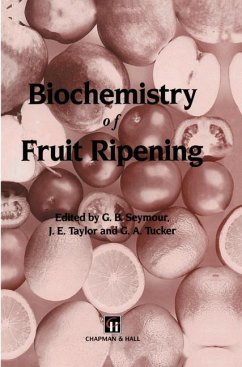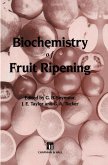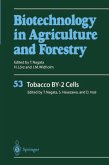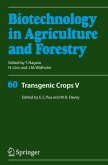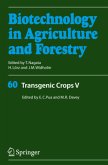- Gebundenes Buch
- Merkliste
- Auf die Merkliste
- Bewerten Bewerten
- Teilen
- Produkt teilen
- Produkterinnerung
- Produkterinnerung
It is over 20 years since the publication of A.c. Hulme's two volume text on The Biochemistry of Fruits and thei.r Products. Whilst the bulk of the information contained in that text is still relevant it is true to say that our understanding of the biochemical and genetic mech
Andere Kunden interessierten sich auch für
![Biochemistry of Fruit Ripening Biochemistry of Fruit Ripening]() Biochemistry of Fruit Ripening252,99 €
Biochemistry of Fruit Ripening252,99 €![Somatic Cell Genetics and Molecular Genetics of Trees Somatic Cell Genetics and Molecular Genetics of Trees]() Somatic Cell Genetics and Molecular Genetics of Trees153,99 €
Somatic Cell Genetics and Molecular Genetics of Trees153,99 €![Tobacco BY-2 Cells Tobacco BY-2 Cells]() Tobacco BY-2 Cells149,99 €
Tobacco BY-2 Cells149,99 €![Somatic Cell Genetics and Molecular Genetics of Trees Somatic Cell Genetics and Molecular Genetics of Trees]() M.R. Ahuja / W. Boerjan / David B. Neale (Hgg.)Somatic Cell Genetics and Molecular Genetics of Trees153,99 €
M.R. Ahuja / W. Boerjan / David B. Neale (Hgg.)Somatic Cell Genetics and Molecular Genetics of Trees153,99 €![Transgenic Crops V Transgenic Crops V]() Eng Chong Pua / Michael R. Davey (eds.)Transgenic Crops V223,99 €
Eng Chong Pua / Michael R. Davey (eds.)Transgenic Crops V223,99 €![Transgenic Crops V Transgenic Crops V]() Transgenic Crops V223,99 €
Transgenic Crops V223,99 €![Pollen Biotechnology Pollen Biotechnology]() R. B. KnoxPollen Biotechnology77,99 €
R. B. KnoxPollen Biotechnology77,99 €-
-
-
It is over 20 years since the publication of A.c. Hulme's two volume text on The Biochemistry of Fruits and thei.r Products. Whilst the bulk of the information contained in that text is still relevant it is true to say that our understanding of the biochemical and genetic mech
Hinweis: Dieser Artikel kann nur an eine deutsche Lieferadresse ausgeliefert werden.
Hinweis: Dieser Artikel kann nur an eine deutsche Lieferadresse ausgeliefert werden.
Produktdetails
- Produktdetails
- Verlag: Springer / Springer Netherlands
- Artikelnr. des Verlages: 978-0-412-40830-4
- 1993.
- Seitenzahl: 472
- Erscheinungstermin: 30. April 1993
- Englisch
- Abmessung: 241mm x 160mm x 34mm
- Gewicht: 951g
- ISBN-13: 9780412408304
- ISBN-10: 0412408309
- Artikelnr.: 23102187
- Herstellerkennzeichnung Die Herstellerinformationen sind derzeit nicht verfügbar.
- Verlag: Springer / Springer Netherlands
- Artikelnr. des Verlages: 978-0-412-40830-4
- 1993.
- Seitenzahl: 472
- Erscheinungstermin: 30. April 1993
- Englisch
- Abmessung: 241mm x 160mm x 34mm
- Gewicht: 951g
- ISBN-13: 9780412408304
- ISBN-10: 0412408309
- Artikelnr.: 23102187
- Herstellerkennzeichnung Die Herstellerinformationen sind derzeit nicht verfügbar.
1 Introduction.- 1.1 Respiration and energy.- 1.2 Flavour changes.- 1.3 Colour changes.- 1.4 Texture changes.- 1.5 Control of ripening.- 1.6 Conclusions.- References.- 2 Avocado.- 2.1 Introduction.- 2.2 Physiology.- 2.3 Biochemistry.- 2.4 Gene expression during fruit ripening.- References.- 3 Banana.- 3.1 Introduction.- 3.2 Ethylene production and respiration.- 3.3 Carbohydrate metabolism.- 3.4 Pigment changes.- 3.5 Cell wall changes.- 3.6 Phenolic compounds.- 3.7 Organic acid and amino acid metabolism.- 3.8 Production of volatile compounds.- 3.9 Lipids.- 3.10 Other changes.- 3.11 Concluding remarks.- References.- 4 Citrus fruit.- 4.1 Commercial importance of citrus fruit.- 4.2 Taxonomy and cultivars.- 4.3 Harvest.- 4.4 Postharvest.- 4.5 General physiology.- 4.6 Biochemical changes during development, ripening and storage.- 4.7 Citrus biotechnology.- References.- 5 Exotics.- 5.1 Introduction.- 5.2 Persimmon.- 5.3 Lychee.- 5.4 Guava.- 5.5 Annona species.- 5.6 Carambola.- 5.7 Tamarillo.-5.8 Passion fruit.- 5.9 Mangosteen.- 5.10 Feijoa.- 5.11 Rambutan.- References.- 6 Grape.- 6.1 Origin and distribution.- 6.2 Grape berry morphology.- 6.3 Fruit growth and development.- 6.4 Growth regulation - phytohormones.- 6.5 Postharvest physiology.- 6.6 Handling and storage.- 6.7 Compositional changes.- 6.8 Phenolic compounds.- 6.9 Aroma.- 6.10 Cell wall metabolism.- References.- 7 Kiwifruit.- 7.1 Introduction.- 7.2 Physiology.- 7.3 Biochemistry.- 7.4 Pathways and enzymes.- 7.5 Regulation of ripening.- 7.6 Future prospects.- References.- 8 Mango.- 8.1 Introduction.- 8.2 Fruit development and harvest maturity.- 8.3 Ripening processes.- References.- 9 Melon.- 9.1 Introduction.- 9.2 Botany.- 9.3 Physiological changes during development and ripening.- 9.4 Biochemical changes during development and ripening.- 9.5 Postharvest diseases and disorders.- 9.6 Genetic improvement.- References.- 10 Pineapple and papaya.- 10.1 The pineapple - an introduction.- 10.2 Pineapple - physiology and biochemistry.- 10.3 Papaya - an introduction.- 10.4 Papaya - physiology.- 10.5 Papaya - biochemistry.- References.- 11 Pome fruits.- 11.1 Introduction.- 11.2 Physiology.- 11.3 Biochemistry.- 11.4 Regulation.- References.- 12 Soft fruit.- 12.1 Introduction.- 12.2 Physiology.- 12.3 Biochemistry.- 12.4 Metabolic pathways.- 12.5 Hormonal regulation of development and ripening.- 12.6 Gene expression during development and ripening.- References.- 13 Stone fruit.- 13.1 Introduction.- 13.2 The Prunus species and their origins.- 13.3 Peaches and nectarines (P. persica).- 13.4 Plum (P. domestica).- 13.5 Mume, or Japanese apricot (P. mume).- 13.6 Apricot (P. armeniaca).- 13.7 Almond (P. amygdalus).- 13.8 Tart or sour cherry (P. cerasus).- 13.9 Sweet cherry (P. avium).- 13.10 Olive (Olea europaea L).- References.- 14 Tomato.- 14.1 Introduction.- 14.2 History and classification.- 14.3 Tomato production.- 14.4 Fruit quality.- 14.5 Ethylene synthesis and action.- 14.6 Temperature stresses and their effects on ripening.- 14.7 The mechanism of tomato ripening.- 14.8 Non-ripening mutants.- 14.9 Cloning and characterization ripening-related mRNAs.- 14.10 Polygalacturonase and its role in texture change.- 14.11 Tomato genetic engineering.- 14.12 Control of fruit-specific and ripening-specific gene expression.- References.- Glossary of botanical names.
1 Introduction.- 1.1 Respiration and energy.- 1.2 Flavour changes.- 1.3 Colour changes.- 1.4 Texture changes.- 1.5 Control of ripening.- 1.6 Conclusions.- References.- 2 Avocado.- 2.1 Introduction.- 2.2 Physiology.- 2.3 Biochemistry.- 2.4 Gene expression during fruit ripening.- References.- 3 Banana.- 3.1 Introduction.- 3.2 Ethylene production and respiration.- 3.3 Carbohydrate metabolism.- 3.4 Pigment changes.- 3.5 Cell wall changes.- 3.6 Phenolic compounds.- 3.7 Organic acid and amino acid metabolism.- 3.8 Production of volatile compounds.- 3.9 Lipids.- 3.10 Other changes.- 3.11 Concluding remarks.- References.- 4 Citrus fruit.- 4.1 Commercial importance of citrus fruit.- 4.2 Taxonomy and cultivars.- 4.3 Harvest.- 4.4 Postharvest.- 4.5 General physiology.- 4.6 Biochemical changes during development, ripening and storage.- 4.7 Citrus biotechnology.- References.- 5 Exotics.- 5.1 Introduction.- 5.2 Persimmon.- 5.3 Lychee.- 5.4 Guava.- 5.5 Annona species.- 5.6 Carambola.- 5.7 Tamarillo.-5.8 Passion fruit.- 5.9 Mangosteen.- 5.10 Feijoa.- 5.11 Rambutan.- References.- 6 Grape.- 6.1 Origin and distribution.- 6.2 Grape berry morphology.- 6.3 Fruit growth and development.- 6.4 Growth regulation - phytohormones.- 6.5 Postharvest physiology.- 6.6 Handling and storage.- 6.7 Compositional changes.- 6.8 Phenolic compounds.- 6.9 Aroma.- 6.10 Cell wall metabolism.- References.- 7 Kiwifruit.- 7.1 Introduction.- 7.2 Physiology.- 7.3 Biochemistry.- 7.4 Pathways and enzymes.- 7.5 Regulation of ripening.- 7.6 Future prospects.- References.- 8 Mango.- 8.1 Introduction.- 8.2 Fruit development and harvest maturity.- 8.3 Ripening processes.- References.- 9 Melon.- 9.1 Introduction.- 9.2 Botany.- 9.3 Physiological changes during development and ripening.- 9.4 Biochemical changes during development and ripening.- 9.5 Postharvest diseases and disorders.- 9.6 Genetic improvement.- References.- 10 Pineapple and papaya.- 10.1 The pineapple - an introduction.- 10.2 Pineapple - physiology and biochemistry.- 10.3 Papaya - an introduction.- 10.4 Papaya - physiology.- 10.5 Papaya - biochemistry.- References.- 11 Pome fruits.- 11.1 Introduction.- 11.2 Physiology.- 11.3 Biochemistry.- 11.4 Regulation.- References.- 12 Soft fruit.- 12.1 Introduction.- 12.2 Physiology.- 12.3 Biochemistry.- 12.4 Metabolic pathways.- 12.5 Hormonal regulation of development and ripening.- 12.6 Gene expression during development and ripening.- References.- 13 Stone fruit.- 13.1 Introduction.- 13.2 The Prunus species and their origins.- 13.3 Peaches and nectarines (P. persica).- 13.4 Plum (P. domestica).- 13.5 Mume, or Japanese apricot (P. mume).- 13.6 Apricot (P. armeniaca).- 13.7 Almond (P. amygdalus).- 13.8 Tart or sour cherry (P. cerasus).- 13.9 Sweet cherry (P. avium).- 13.10 Olive (Olea europaea L).- References.- 14 Tomato.- 14.1 Introduction.- 14.2 History and classification.- 14.3 Tomato production.- 14.4 Fruit quality.- 14.5 Ethylene synthesis and action.- 14.6 Temperature stresses and their effects on ripening.- 14.7 The mechanism of tomato ripening.- 14.8 Non-ripening mutants.- 14.9 Cloning and characterization ripening-related mRNAs.- 14.10 Polygalacturonase and its role in texture change.- 14.11 Tomato genetic engineering.- 14.12 Control of fruit-specific and ripening-specific gene expression.- References.- Glossary of botanical names.
... the Biochemistry of Fruit Ripening is aimed at all those involved in planning, harvesting, transport and storage of fruit.... to emphasise in particular the advances made in the last 20 years. - Comment; ...400 well documented pages...In summary, this book should allow a researcher or teacher unfamiliar with this area to assemble biochemical information concerning a wide range of individual fruits efficiently - Plant Science

